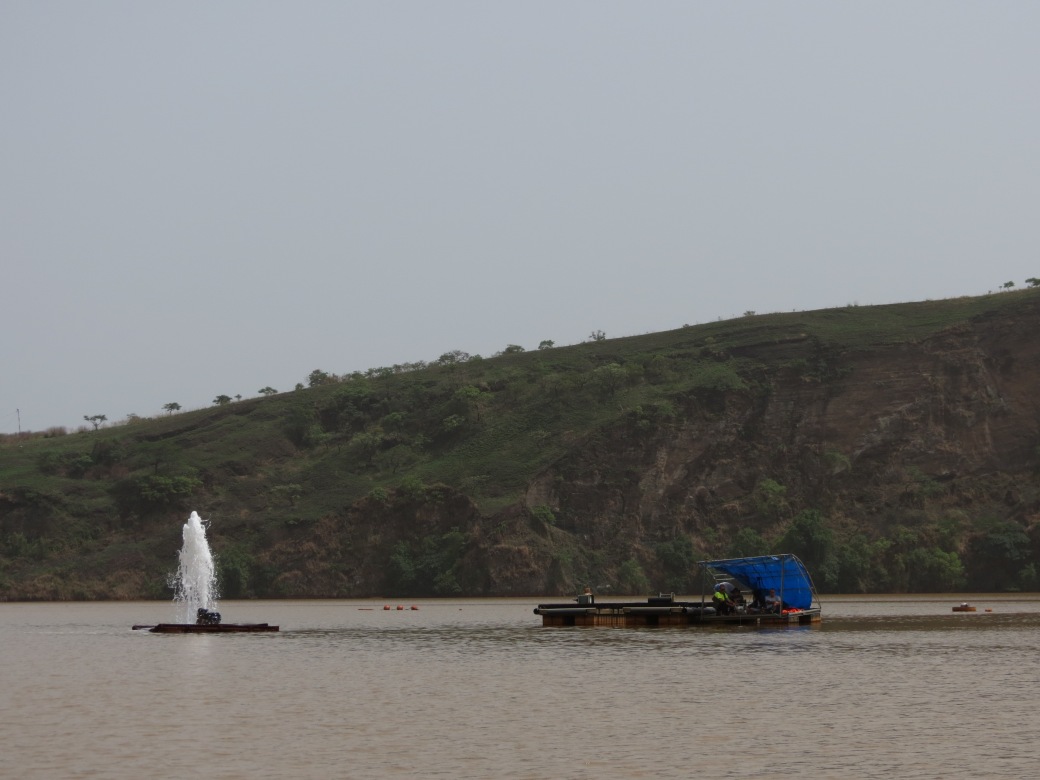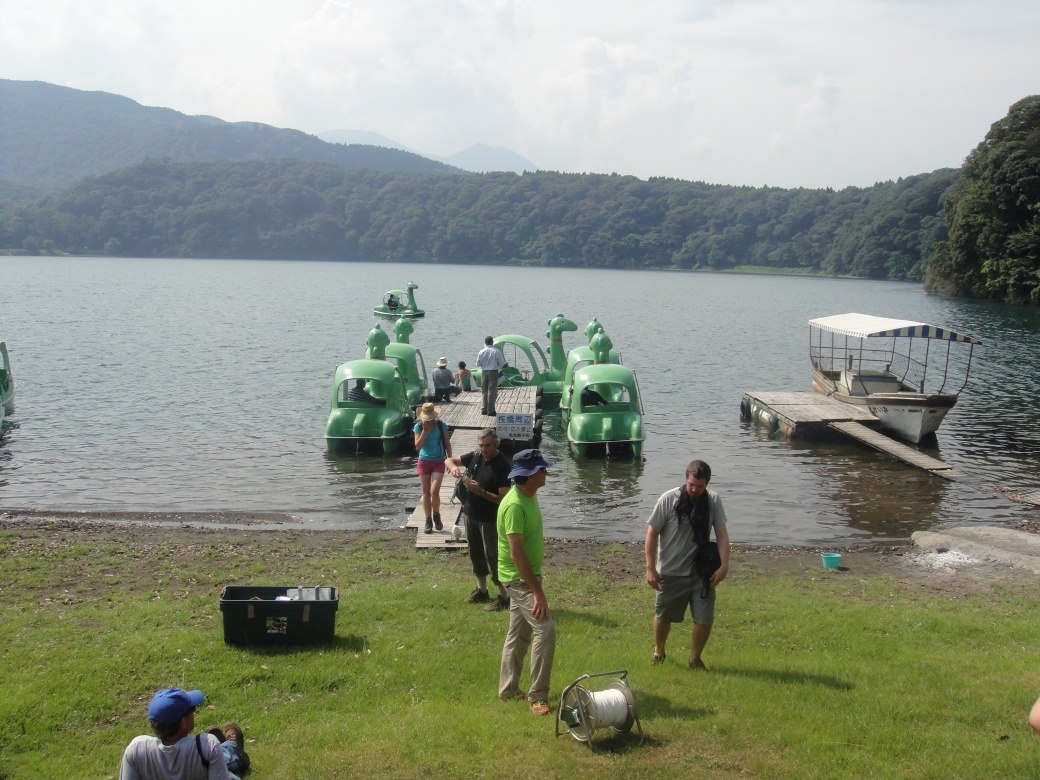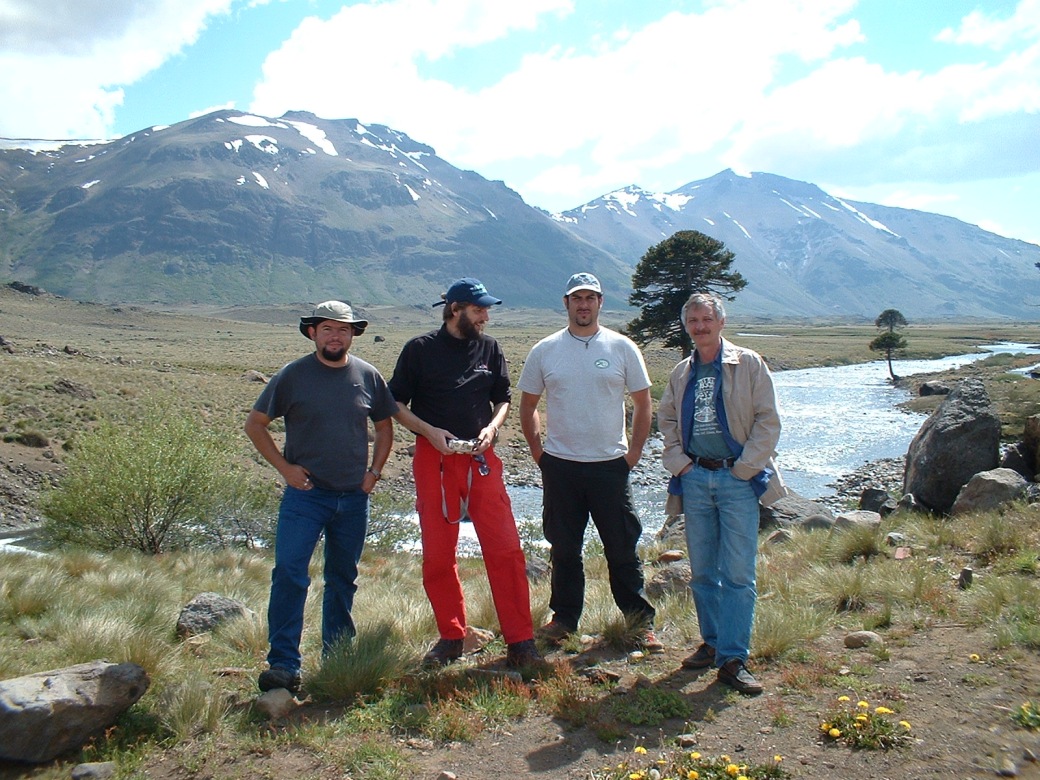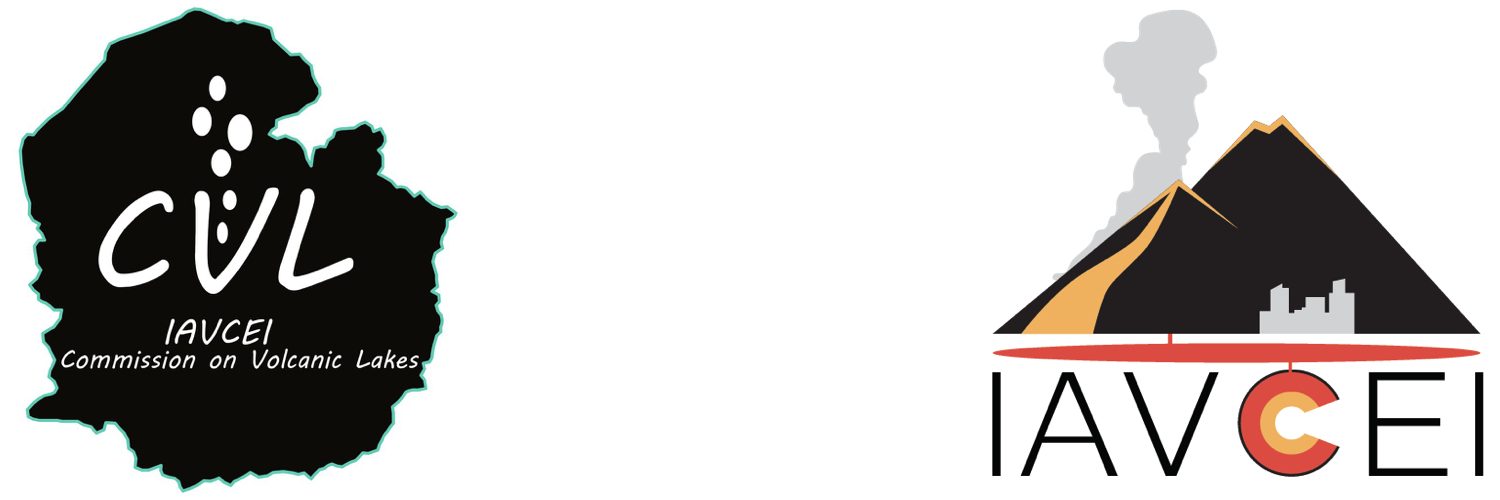Meeting “live” during the regular workshops (triannual, possibly) is the key dynamics to keep our scientific community teased, curious, excited/exciting, surprised, united, in syntony, creative…
Below you can track the CVL history and evolution throughout our workshops, from the most recent one in 2019, to the first ones in the early 1990’s.
CVL10-New Zealand, March 2019
After CVL9-Cameroon in March 2016, the IAVCEI Commission of Volcanic Lakes (CVL) reunited for CVL10 in Taupo, New Zealand, from 17 to 25 March 2019.
The meeting aimed at bringing together volcano scientists from a wide range of sub-disciplines, including physical volcanology, hydrology, limnology, biochemistry, geochemistry and geophysics, all with a view toward establishing broad communication amongst the disciplines and development of holistic models of volcanic lake environments. The goals of the workshop are to provide ample opportunity for exchange of ideas around data collection and monitoring methodologies in volcanic lake environments, hazard recognition and mitigation, and copious discussion of conceptual models for so-called “wet volcanic systems”.

Cindy Werner, Yuri Taran and Jennifer Lewicki during the ice-breaking cocktail at Great Lake Centre, Taupo, March 17 (pic by Yuri Taran).

Akihiko Terada and Bruce Christenson during the ice-breaking cocktail at Great Lake Centre, Taupo, March 17 (pic by Yuri Taran).
Thirty-two participants from 12 countries attended the workshop, which was organised by Bruce Christenson, Agnes Mazot, Karen Britten and Brad Scott of Geological and Nuclear Science, New Zealand.
During the first three days (18-20 March 2019), seven different symposia were organised at the Great Lake Venue in Taupo, tackling the various topics of what volcanic lake research stands for: (1) Tracking lake water chemistry-The future of direct sampling of volcanic lakes (convened by María Martínez-Cruz Céline Mandon and Takeshi Ohba, 11 talks), (2) Gas emissions from acidic crater lakes (convened by Cindy Werner and Orlando Vaselli, 3 talks + 2 posters), (3) Hydrothermal systems surrounding volcanic lakes-surveys and models (convened by Joop Varekamp and Jennifer Lewicki, 6 talks), (4) Phreatic eruptions form Wet Volcanoes (convened by Bruce Christenson and Akihiko Terada, 5 talks), (5) The impact of volcanic lakes on society-from mythology to risk mitigation (convened by Hollei Gabrielsen and Dmitri Rouwet, 3 talks), (6) Limnology of Lake Nyos and its nephews-searching for strata (convened by Minoru Kusakabe and Bill Evans, 5 talks + 2 posters), and (7) Carbon dioxide degassing at volcanic lakes-theory and practice (convened by Artur Ionescu and Agnes Mazot, 4 talks). In the afternoon of day 2, the Phreatic Eruption symposium was followed by a round table session entitled “The role of crater lakes in forecasting phreatic eruptions”, panelled by Nico Fournier, Art Jolly, Bruce Christenson, Akihito Terada, Jennifer Lewicki, Takeshi Ohba, and Dmitri Rouwet. Notes were taken by Craig Miller. A major observation, also in the aftermath of the Ontake-2014 and Ruapehu-2007 phreatic eruptions, was: Is there such a thing as “blue sky eruption?” Or, are we not just detecting it? Answering this question remains a challenge for future research.

Question rounds during scientific sessions at Great Lake Centre, Taupo (pic by Yuri Taran).
The scientific sessions were closed by the CVL Business Meeting (20 March 2019), that reported on the CVL activities of the past 9 years, from CVL7-Costa Rica-2010, over CVL8-Japan-2013, to CVL9-Cameroon-2016, until CVL10-New Zealand-2019. A positive balance of the commission’s activities was acknowledged by the commission members and participants. After nine years Dmitri Rouwet (INGV-Bologna, Italy) stepped back as the CVL Leader; Corentin Caudron (Université de Savoie, France, not present) and Jennifer Lewicki (USGS-Menlo Park, USA) were unanimously elected as the new CVL-co-Leaders. Bertram Boehrer (GFZ, Germany), Alain Bernard (ULB, Belgium) and Takeshi Ohba (Tokai University, Japan, ex-CVL Secretary, 2010-2013) decided to leave the CVL-Steering Committee. Céline Mandon (Yachay Tech University, Ecuador), Akihiko Terada (KSVO-TIT, Japan) and Maarten de Moor (OVSICORI, Costa Rica, not present) were added to the team of SC members, that is now composed of Bruce Christenson (CVL Secretary), Dmitri Rouwet (CVL webmaster), Greg Tanyileke (IRGM, Cameroon, ex-CVL Secretary 2013-2016), Agnes Mazot, Franco Tassi, Jacopo Cabassi (University of Florence, Italy), Raúl Mora-Amador (UCR, Costa Rica), Céline Mandon, Akihiko Terada, Maarten de Moor, and the two new co-Leaders Caudron and Lewicki.
This refreshed SC represents all continents, all ages and levels of experiences, besides all research fields of volcanic lake studies. Shortly after CVL10, the SC decided to organise the CVL11 Workshop in early 2022 at Lake Taal in the Philippines. CVL is delighted to bring the research group together at this enigmatic and potentially dangerous lake hosting volcano. The organisation of CVL11-2022-Philippines is in hands of Corentin Caudron, Alain Bernard and Phivolcs. The workshop will soon be promoted through IAVCEI newsletter, CVL mailing lists and on the CVL website https://iavcei-cvl.org/ and social media (https://www.facebook.com/Commission-on-Volcanic-Lakes-204310646248839/). See you all at the shore of Lake Taal in early 2022!

Champagne Pool, Wai-o-Tapu Geothermal Park (pic by Joop Varekamp).

Group picture at the Tama Lakes (pic by Karen Britten).

Bruce Christenson and Brad Scott supervising the campaign at Lake Rotomahana, Waimangu Volcanic Valley (pic by Yuri Taran).


Sampling of lake water and dissolved gases along the vertical profile of Lake Rotomahana, Waimangu Volcanic Valley (pics by Karen Britten and Yuri Taran).
In the evening of March 20, the next Winner of the 2019-Kusakabe Award was announced during the Conference Dinner-Barbeque at the at Debrett’s Thermal Spa. The three nominated “heavy-weights” of our research during the past three decades, elected by the 2016-2019 CVL Steering Committee and an external evaluation commission, were: Bruce Christenson, Alain Bernard and Joop Varekamp (Wesleyan University, CT-USA). Joop Varekamp resulted the Winner of the 2019-Kusakabe Award. Congratulations Joop! Well deserved… thank you for your decades-long commitment, innovating and eclectic research and guidance.

CVL-Haka, Rotorua (pic by Yuri Taran).
After the scientific sessions and official Business Meeting CVL10 continued with field trips at the Tama Lakes (between Mt. Ruapehu and Mt. Ngauruhoe), Huka Falls, Wairakei Geothermal field, Wai-o-Tapu Geothermal Park, and joint sampling and measurement campaigns at Waimangu Volcanic Valley with a special focus on Lake Rotomahana (out of Rotorua). A climb to the Ruapehu Crater Lake with the entire group could, unfortunately, not take place due to adverse weather conditions. Needless to say that the magmatic-hydrothermal features in these field trips were breathtaking as well as very didactical. The group split on 25 March; some members decided to visit White Island/Whakaari independently.

Group picture during the Maori dinner in Rotorua (pic by Yuri Taran).
The 2,000 € support by IAVCEI was awarded (5 x 400 €) to the young researchers/students, coming from overseas: Gino González (Costa Rica), Kaori Seki (Japan), Céline Mandon (Ecuador), Kyriaki Daskalopoulou (Greece), and Artur Ionescu (Romania).
CVL9-Cameroon, March 2016
After the tragic limnic gas burst at Lake Nyos on 21 August 1986 volcanic lake research boosted worldwide. Since then, 30 years have past. To commemorate this event, the IAVCEI-CVL converged in Cameroon’s capital Yaounde for its 3-yearly Workshop. Considering the historical role of Lake Nyos, bringing IAVCEI-CVL back to Cameroon 30-years-after is a major accomplishment, and a hinge moment for the commission.
The workshop was inaugurated by the Minister of Scientific Research and Innovation, Dr. Madeleine Tchuinte. Many local students besides 65 participants from 11 countries attended the workshop, which was organized by Greg Tanyileke and colleagues (Wilson Fantong, Aka Festus and others) from the Institute of Geological and Mining Research (IRGM, Cameroon), and supported by the International Union of Geodesy and Geophysics. 32 talks were presented during the first three days of the workshop (14-16 March 2016, Hotel Mont Fébé). The Italian team was the largest foreign group.
Key review lectures by Nyos-pioneers Minoru Kusakabe (Japan), George Kling (USA), and J-C Sabroux (on behalf of Michel Halbwachs’ team, France) brought heavy-weight to the meeting. The scientific event showed that the initial controversy on Lake Nyos has been replaced by harmony and agreement. After fifteen years of risk mitigation actions by artificial degassing of Lake Nyos, the lake is considered relatively safe.
The decades-long dedication and project management, supported mainly by Japan International Cooperation Agency, is a laudable example of international collaboration and capacity building, unique and exemplary. Several Cameroonian experts have now returned home after their PhD in Japan, to self-sufficiently follow up research on their lakes.

Participants of the CVL9 workshop, Cameroon 2016. picture by A. Folch.
Lake Nyos was visited on 19 March 2016 for a multi-disciplinary sampling and measurement campaign. On 22 March an in-depth survey of Lake Barombi Mbo, largest maar lake in Cameroon, was undertaken.

Lake Nyos, early mourning 19 March 2016. picture by D. Rouwet.

Logistics meeting at the Lake Nyos lodge. picture by D. Rouwet.

Field work at Lake Nyos, 19 March 2016. picture by D. Rouwet.
How it’s like being together all day on a raft in the middle of a huge lake, Barombi Mbo field work, Cameroon. video by D. Rouwet.

Transport at Barombi Mbo, Cameroon. picture by D. Rouwet.

Barombi Mbo, the largest maar lake in Cameroon. picture by D. Rouwet.

Rafts need anchors, Barombi Mbo, Cameroon. picture by D. Rouwet.
The meeting confirmed the IAVCEI-CVL as a compact, united, and active group of passionate researchers, assuring creative and socially responsible research for this niche topic in the future.
The CVL Steering Committee awarded Minoru Kusakabe for his role as the “CVL founding father” and career-long dedication to Lake Nyos and, especially, for his efforts towards capacity building of Cameroonian researchers. In his name and example, the CVL will award the “Kusakabe Award” every three years.
Dmitri Rouwet, Greg Tanyileke and Antonio Costa published the detailed EOS CVL9 Meeting report.
CVL8-Japan, July 2013
For the second time in CVL history our workshop was linked to the IAVCEI Scientific Assembly held in Kagoshima, Japan, in July 2013. The theme of the workshop was called: Properties and behavior of volcanic lake as a constituent in teh magma-hydrothermal system. CVL8 was organized by T. Ohba, B. Chako Tchamabé and their co-workers. 50 researchers from 16 countries attended CVL8. The Japanese hosts and the Cameroonians were the most represented delegations. CVL8 was finncially supported by IAVCEI and teh Earthquake Research Institute of the University of Tokyo. 43 studies were presented during 9 sessions with varying topics such as (1) hazard mitigation involving crater lakes, (2) geophysical studies of crater lakes, (3) geochemical studies of crater lakes, (4) volcanology of crater lakes, (5) biological studies of crater lakes, (6) limnology, (7) hydrology of crater lakes, (8) modeling, simulations and innovative studies on crater lakes, and (9) physical studies of crater lakes.

Illumination and enlightenment during a talk by B. Christenson, Kumamoto. picture by R. Mora-Amador.

Participants of the CVL8 workshop at Kumamoto University, Japan 2013. picture by M. Kusakabe.
Prior to the scientific sessions at Kumamoto University, the Kirishima volcanic area, known for its 26 January 2011 crater lake breaching eruption, was visited. Two days later the group took a glimpse of the almost vanished famous Yudamari crater lake of the highly active Aso volcano.

“Dino-rafting” in the Kirishima volcanic area, Japan. picture by D. Rouwet.

A famous crater lake just before its dry-out, Yudamari, Aso volcano, Kyushu, Japan. picture by D. Rouwet.

At the Aso summit observation point. C. Ramírez, Aso gas specialist and former CCVG Leader H. Shinohara, G. González.

D. Rouwet in front of an Aso banner: how it would have looked like. picture by R. Mora-Amador.
Flying from the heat of Kyushu’s Fukuoka to the cooler temperatures of Hokkaido, field work continued in the area squeezed between Lake Toya and Usu, the volcano affected by the surreal bradyseismic and erupive activity in 2000, where volcanic lakes cover the volcano flank. In the evenings the participants tasted from the Japanese Onzen culture and marvellous food, after visiting the Noboribetsu geothermal area, at the outskirts of Lake Kuttara, for pH1 water sampling of the lakes and springs.

Noboribetsu geothermal area, Hokkaido, Japan. picture by J. Cabassi.

Lake Toya, Hokkaido, Japan. picture by D. Rouwet.

Crater lake at Usu flank with Lake Toya in the background, Hokkaido, Japan. picture by D. Rouwet.

Participants of the Hokkaido field trip of the CVL8 workshop (Usu Volcano Observatory), Japan 2013.
After the CVL8 workshop Takeshi Ohba, Corentin Caudron and Bruno Capaccioni took the initiative to edit a Special Volume in the Geological Society of London series entitled Geochemistry and Geophysics of Active Volcanic Lakes, including studies presented during the CVL7-Costa Rica and CVL8 workshops.
CVL7-Costa Rica, March 2010
After an unusual break of almost 6 years since CVL6-Argentina (2004), volcanic lake researchers reunited in Costa Rica, in spite of being a small country, the home to three crater lakes topping active volcanoes (Poás’ Laguna Caliente, Irazú and Rincón de la Vieja) and two presumably “Nyos-type” lakes (Laguna Hule and Río Cuarto). The main goal of CVL7 was to get a realistic picture of what lake research stands for anno 2010, by attracting the most representative group of participants -lake pioneers as well as new-entries, fluid geochemists as well as biologists and limnologists. 51 participants from 14 countries attended CVL8 that was organized by the locals R. Mora-Amador and C. Ramírez (Universidad de Costa Rica, UCR) and M. Martínez-Cruz (OVSICORI). 27 seminars were presented during the first two days at UCR, followed by a poster session during a visit at OVSICORI.
During the traditional field work at CVL workshops, sampling at Poás’ Laguna Caliente was omitted for safety reasons, after the Christmas 2009 surprise phreatic eruption that converted Poás in the most active crater lake for the years to come. Instead, Laguna Botos, the clear water lake near the summit of the volcano was probed.

Rafting at Laguna Botos, Poás (Costa Rica). picture by D. Rouwet.
The main sampling and measurement campaign (CO2 flux, probing and sampling at depth) was held at the poorly studied Laguna Hule and Río Cuarto “Nyos-type” maar lakes, known to overturn once in a while. Results of this group effort, representative of the team spirit during CVL7, is published by J. Cabassi et al., introducing “bio-activity lakes”.

Laguna Hule, Costa Rica. Note the raft in the middle of the lake for scale. picture by R. Mora-Amador.

Sampling and probing at depth from rafts (up), and CO2 fluxing (lower) from the Laguna Hule lake surface. picture by R. Mora-Amador.

Río Cuarto’s turned over just before CVL7. picture by R. Mora-Amador.

Participants of the CVL7 workshop gathered at Laguna Hula, Costa Rica, 2010.
CVL7 kickstarted the activities of the “new” CVL Steering Committee, a mix between experience and youngsters, exactly what CVL7 mirrored.
During CVL7 Dmitri Rouwet proposed to publish the first monograph on Volcanic Lakes that was eventually published by Springer in March 2015.
Dmitri Rouwet and Takeshi Ohba published the EOS CVL7 Meeting report.
CVL6-Argentina, November 2004
The CVL6 workshop was organized by Joop Varekamp, Alain Bernard, Adriana Bermúdez and Daniel Delpino in Caviahue, Argentina, after the IAVCEI Scientific Assembly in Pucón, Chile, in November 2004. 27 participants originating from 11 countries attended CVL6. To reach the shores of Lake Caviahue, at the foot of the crater lake bearing Copahue volcano, a mini-van transported the participants from Pucón across the border to Caviahue. Lake Caviahue is an acidic (pH 2-3) Patagonian lake dammed by volcanic deposits, resulting in the particular bifurcated basin: a lake with two long arms.


Reaching Caviahue. picture by R. Mora-Amador.
The first days talk sessions were organized in the lodge of the village. Talks by B. Takano, J.C. Varekamp, M. van Bergen, C. Ramírez, A. Bernard, Y. Taran, and D. Rouwet, followed by talks on the peculiar local setting, are remembered. The atnosphere during the workshop was familiar as always, and CVL6 reflected a good mix between students (the young M. de Moor, A. Goss, D. Rouwet, R. Mora-Amador, C. Ramírez, L. Trunk) and lake pioneers. CVL6 was the last workshop “Boku” Takano participated, before retiring.

Patagonian Araucarias, living fossils, on Copahue’s flank. picture by R. Mora-Amador.

Lake Caviahue within the Caviahue depression. picture by R. Mora-Amador.

Waterfall. picture by R. Mora-Amador.

Another waterfall. picture by R. Mora-Amador.

R. Mora-Amador, J.C. Varekamp, C. Ramírez and Y. Taran. picture by R. Mora-Amador.

Columnar joints in the amazing Caviahue-Copahue area. picture by R. Mora-Amador.
The next day a group climbed to the crater lake and near-summit acidic flank springs of Copahue volcano, while a second group sampled the hydrothermal manifestations of Las Máquinas and Las Maquinitas. All these fluids were sampled, from the summit lake, the flank springs to the fumarolic, bubbling and geothermal well gases at the foot of Copahue.

Then CCVG Leader Yuri Taran and his late wife Luci sampling bubbling gases from hot springs at Las Máquinas. picture by R. Mora-Amador.
Following CVL6 J.C. Varekamp and M. van Bergen edited a Special Volume in JVGR (2008, Vol. 178/2) containing 17 papers.

A more recent picture of Copahue crater lake, prior to the December 2012 eruptions. picture by A. Caselli.
CVL5-Indonesia, July 2000
The CVL5 workshop was held as one of ten symposia of the IAVCEI General Assembly in July 2000 in Bali, Indonesia convened by A. Bernard, T. Sriwana and J.C. Varekamp. This was the first time that the CVL workshop was synchronous with an IAVCEI General Assembly. The main objectives of the meeting were (1) the numerous interesting perspectives offered by the geochemical and geophysical monitoring of crater lakes, (2) the specific hazards related to the existence of lakes in the crater of active volcanoes, and (3) the impact on the environment of the discharge of ultra-acid fluids. These objectives are consistent with the scope of CVL. A fascinating field trip to visit Indonesian active volcanic area including lakes was organized just prior to the meeting. The trip included visits to Dieng, Kelut, and Ijen volcanic complexes. (modified from M. Kusakabe)

The largest hyperacidic crater lake on Earth, the enigmatic Kawah Ijen at dawn, Java, Indonesia. picture by D. Rouwet.
CVL4-USA, 1996
The CVL4 workshop was organized by J.C. Varekamp and G.L. Rowe in 1996 at Crater Lake, Oregon, under the title “Crater lakes, terrestrial degassing and hyper-acid fluids in the environment”. The meeting was attended by ~70 scientists with backgrounds in volcanology, geochemistry, hydrology, limnology, microbiology and economic geology. The subjects discussed were further expanded, but consistent with those already strewed in the previous CVL meetings. Altogether 68 studies were presented for the physical and chemical characteristics of volcanic lakes, the geochemistry and microbiology of hyper-acid (pH< 1) fluids found in crater lakes, geothermal, and acid-mine drainage environments, the rates and mechanisms of magmatic degassing in near-surface environments, and acid fluid-rock reactions and their role in alteration and mineralization associated with epithermal ore deposits. A detailed EOS CVL4 Meeting report was published by J.C. Varekamp and G.L. Rowe (1997: Exotic fluids in the exosphere: When Hades meets Apollo, meeting report. EOS 78, 237-239). Of the studies presented at this meeting 26 papers with a total of 350 pages was published in JVGR (2000, Vol. 97) as a special issue on “Crater Lakes” (edited by J.C. Varekamp and G.L. Rowe). (modified from M. Kusakabe)

Crater Lake and Wizard Island, Oregon, USA. picture by D. Rouwet.
CVL3-Russia, 1995
The International Association of Volcanology and Chemistry of the Earth’s Interior (IAVCEI) welcomed IWGCL as a commission in 1993, rebaptising it the Commission on Volcanic Lakes (CVL). The CVL3 workshop was organized by S.M. Fazlullin in Vladivostok (Russia) in 1995 as part of the 8th International Symposium on Water-Rock Interaction of IAGC. The meeting was attended by ca. 40 people under the section “Physical-chemical processes in crater lakes”. Eleven papers presented at this section were published in the Proceedings of WRI-8 (1995). The geochemistry and bio-geochemistry of acid crater lakes and impact of active crater lakes on the environment were discussed. At that time, the latter subject was a new entry for the CVL community.

The meeting was coupled with a field workshop in Kamchatka, which provided a rare opportunity to visit several crater lakes that are located at difficult-to-access places. Chemical analysis of highly acid and concentrated water is problematic, and an intercalibration of Maly Semyachik crater lake waters was attempted. The attendees analyzed the lake water using their own analytical methods and instruments. The meeting report by Fazlullin appeared in our Newsletter (“Current research on Volcanic Lakes”, No. 9, p. 38-39, 1996). The results of this intercalibration was published in the JVGR special issue (97:497-508, 2000) on “Crater Lakes” as ‘Analytical laboratory comparison of major and minor constituents in an active crater lake’ by Takano, Fazlullin and Delmelle. (written by M. Kusakabe)
CVL2-Japan, 1992
The scope of IWGCL was expanded in its 2nd meeting (organized by M. Kusakabe in 1992 at Misasa, Japan) to include not only studies of gassy lakes in Cameroon, but also those of other volcanic lakes in general. The objectives were to obtain information on activity and degassing state of shallow magmatic bodies so that forecasting volcanic eruptions and mitigation of volcanic lake-related hazards can be achieved. Three meeting reports were published: a detailed one by K. Tietze in our Newsletter (“International Working Group on Crater Lakes Newsletter”, No. 6, p. 5-18, 1993), a short one by M. Kusakabe & K. Tietze in the Newsletter of the World Organisation of Volcano Observatories (“WOVO News”, No. 3, p. 3-4, 1993) and a short one by M. Kusakabe in EOS (Vol. 74, p. 325, July 20, 1993). Papers presented at the Misasa meeting were published in a Special Issue of Geochemical Journal “Geochemistry of Crater Lakes”, edited by M. Kusakabe.
After this meeting, IWGCL acquired formal IAVCEI status as Commission on Volcanic Lakes (CVL) after a short period as a Task Group in 1993. The IAVCEI Executive Committee at that time encouraged cooperation with IAHS (International Association of Hydrological Sciences), but this was practically difficult because the CVL meetings were organized independently from IAVCEI and IAHS general assemblies. However, later meetings proved that involvement of scientists from the fields of hydrology, limnology, oceanography and microbiology in addition to volcanology and geochemistry was indispensable in order to achieve the goals of the community of volcanic lake studies. (written by M. Kusakabe)

Misasa Onzen, Japan. Source internet.
CVL1-France, 1990
On 21 August 1986 a lethal CO2 cloud burst from the bottom waters of Lake Nyos in northwestern Cameroon, killed 1746 people and over 3000 livestock. After early discussions on the process behind this gas release (volcanic vs limnic eruption), during the International Conference on the Lake Nyos Gas Disaster in Yaoundé in March 1987, the International Working Group on Crater Lakes (IWGCL) was born. The main body of the current Commission on Volcanic Lakes was created initially as the International Working Group on Crater Lakes (IWGCL) in 1987 when the International Conference on the Lake Nyos Gas Disaster was held in Yaounde, Cameroon. The purposes of IWGCL at that time were to exchange scientific information about the Lake Nyos gas disaster, to adjust the follow-up field works planned by those who were interested in this subject, and to organize scientific meetings as a forum for further studies. When Lake Nyos’ bottom water naturally recharged with CO2 in the years post-1986, it became clear that the limnic eruption hypothesis with consequent CO2 release was the most likely.

Post-Nyos eruption, 1986. picture by P. Turnley ©
The first IWGCL meeting (organized by S.J. Freeth in 1990 at Nancy, France) published an important communique (Freeth et al., Nature 348, p.201, 1990) that Lake Nyos still remained dangerous because of its high CO2 content that was increasing at an alarming rate and that the lake could be made safe through artificial degassing. (modified from M. Kusakabe)

